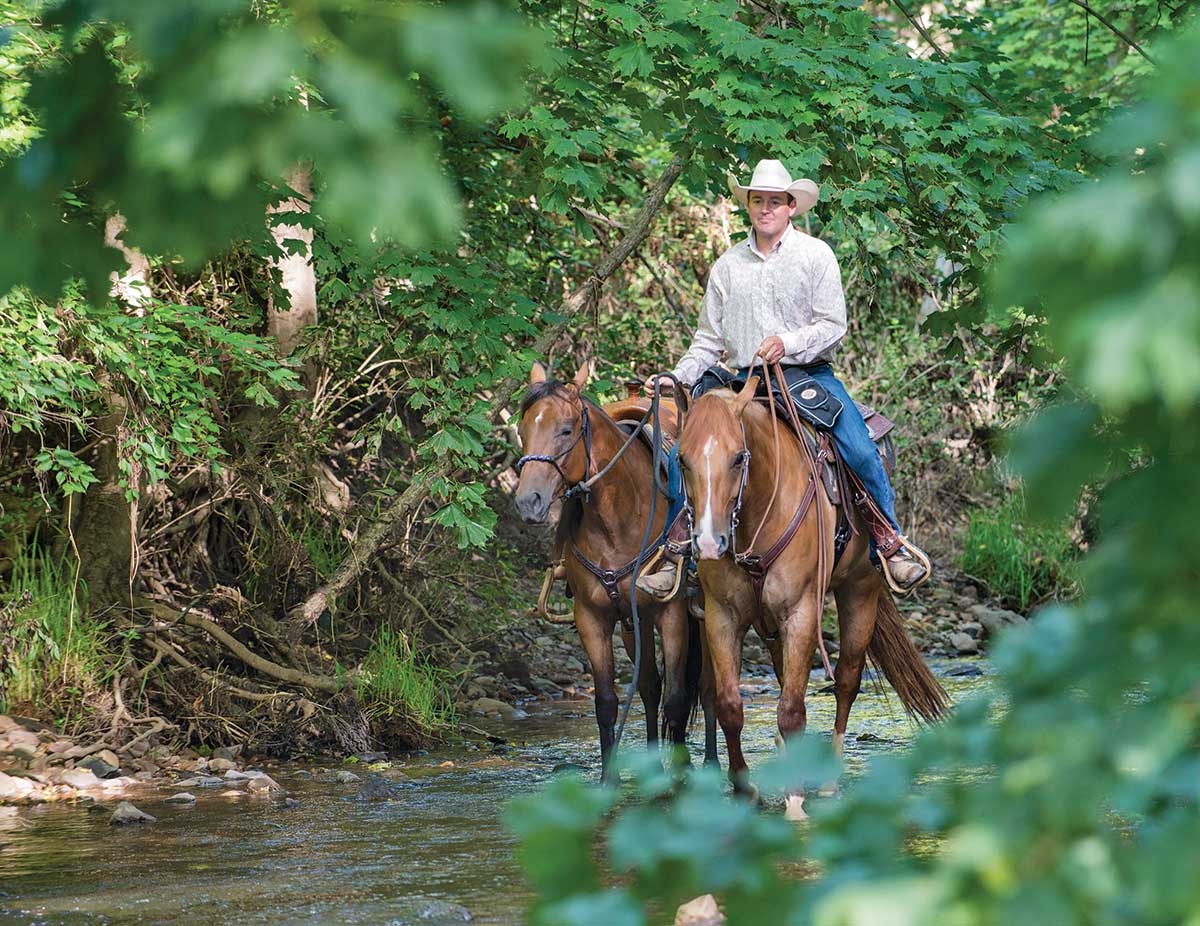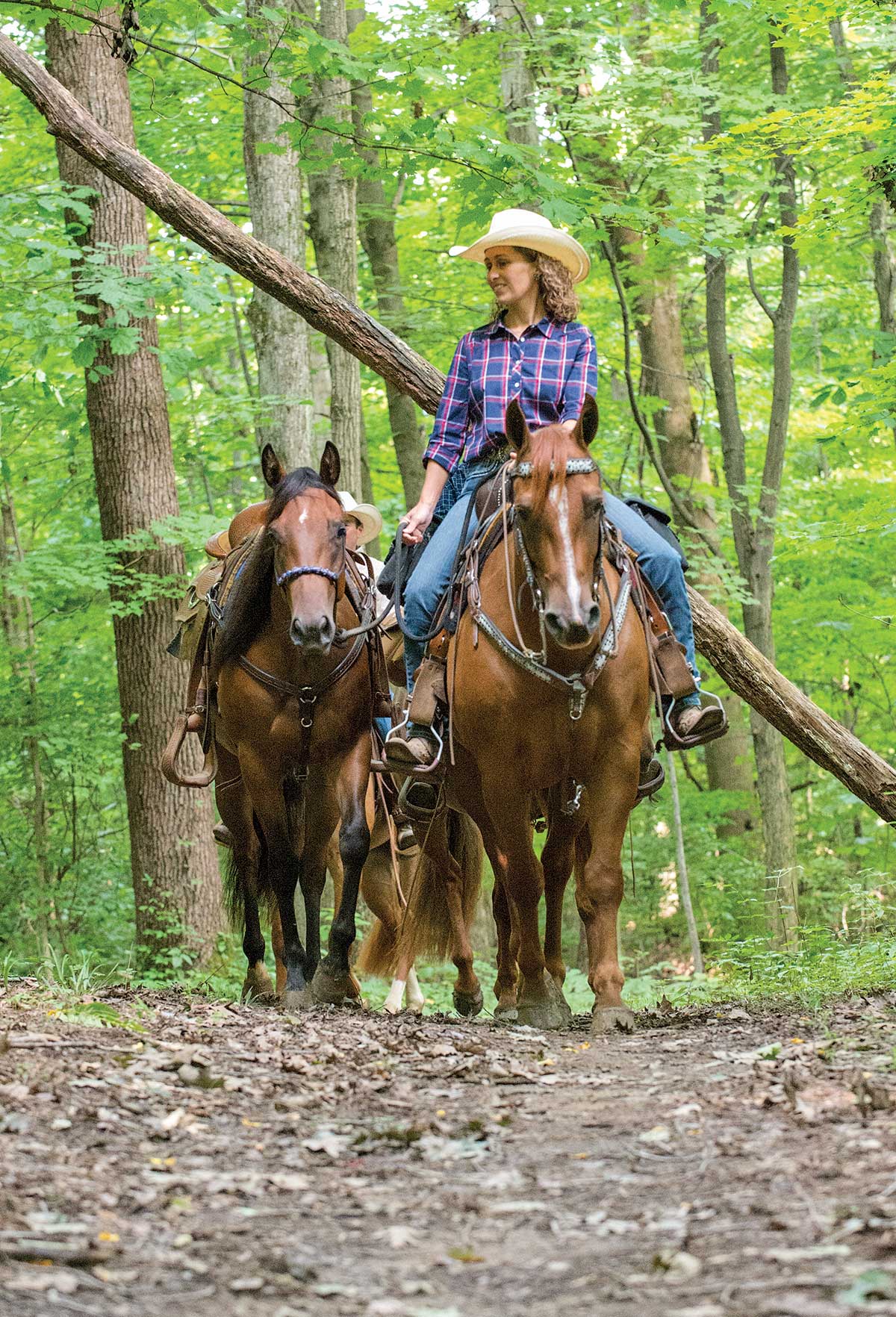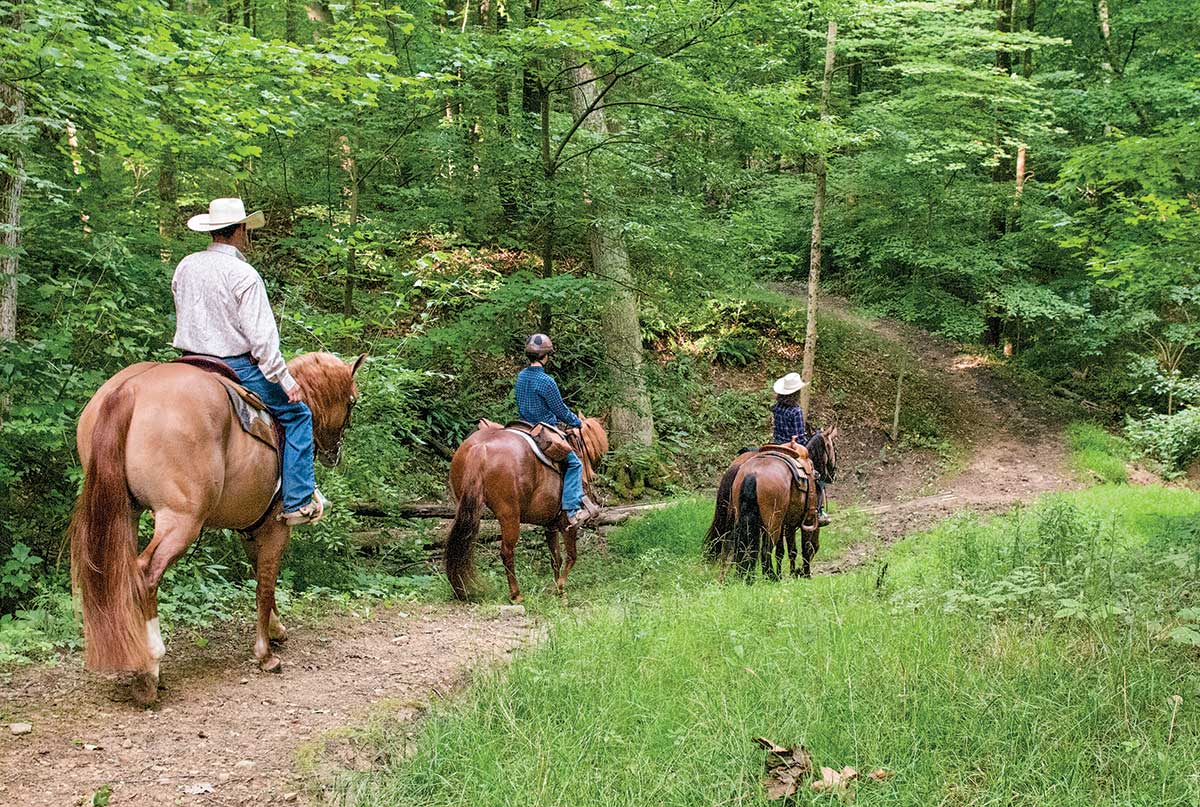
Proper trail conditioning your horse means strengthening both his body and his mind. A strong, balanced horse will climb steep hills with confidence, step down to water crossings with agility, and be well-equipped to tackle other challenging trail obstacles. An unconditioned, ill-prepared, worried horse will tend to falter on the trail and question your leadership abilities.
Conditioning your horse for the trail means strengthening both his body and his mind. A strong, balanced horse will climb steep hills with confidence, step down to water crossings with agility, and be well-equipped to tackle other challenging trail obstacles. An unconditioned, ill-prepared, worried horse will tend to falter on the trail and question your leadership abilities.
Ready to plan your horse’s spring conditioning program—for mental and physical preparedness? Here we’ll give you conditioning plans for a young (green) horse and for well-trained, mature horse.
Young-Horse Conditioning
Young horses don’t have the skills and experience to balance well when traveling on steep or slippery footing. They also haven’t been exposed to on-trail sights, sounds, and smells. As you condition your young horse, choose terrain that won’t cause him to lose his balance or slip. Set him up for success to strengthen his body without damaging his psyche. Misjudging the terrain can teach your youngster to fear the trail instead of conditioning his body and mind to take on increasing challenges. →
Physical Conditioning
Pick the right spots for your youngster’s first trail ride. Plan a short ride over terrain with which you’re familiar. Ride out and back on the same trail instead of riding on a loop trail, or ride out and back on the easiest part of a loop trail, then extend your ride as he becomes more conditioned.

We suggest ponying your young horse during his first trail rides so that he can learn to balance himself on varying terrain before adding the challenge of a rider. It allows you to gauge your green horse’s reactions to new obstacles and see how hard he’s working. With your youngster’s head right next to your leg you can see if he’s breathing heavily and flaring his nostrils. (For ponying tips, turn to page 72.) On the trail, make sure the path is wide enough for both horses.
Record his resting and post-workout respiration rates at home. (Learn how to take your horse’s vital signs at HorseandRider.com.) As you pony him, compare his respiration rate to his normal rate. If he appears to be exerting too much, walk him home, and plan a shorter ride the following day.
When we conditioned our two young horses, we picked a familiar loop trail, riding over an easy hill and across the water, then turning back. We saved a steeper hill and slippery water crossing for later, when our youngsters were ready to tackle the whole loop.
We ponied each horse three to five times before riding them independently. Then one of us would ride a well-trained horse, and the other would ride a young horse while staying in the ponying position. This allowed the young horse to see how the older horse took on the terrain and kept him feeling safe and confident.
Ride just 15 minutes out and 15 minutes back. Watch his fatigue level, keeping in mind that his nerves can add to his fatigue. Repeat this routine at least three times per week, riding the same 30-minute path over and over until your youngster is no longer overexcited (head up and looking around) and actually seems a bit bored with the trail (head down and relaxed). Then extend your ride by another 15 minutes or ride an entire loop trail. As he relaxes, he’ll handle more physical exertion as he isn’t wasting energy on stress.

Mental Conditioning
When you repeat the same trail ride over and over, you’re encouraging your youngster to think, “Oh, we’re doing this again.” This repetition will help him to gain confidence and boost his mental conditioning. He knows that part of the trail is safe and what to expect. He also knows he can handle the ride—that he’s strong enough to finish the ride with energy to spare.
Your youngster’s mental condition is closely tied to his physical condition, so don’t allow him to become overtired, dragging himself along the trail. If he appears tired or sore he may be less likely to perform well during the next ride. You might accidentally teach him that trail riding is hard. Physically overextending your young horse will cause him to question you.
Be alert for what your youngster needs. Go at his pace, and allow for frequent breaks, before he stops on his own. Plan ahead. If there’s a steep hill, plan on providing a rest stop in a safe location halfway up and again once you reach the top. This will help him learn to trust you. Your youngster is working hard to carry you down the trail. Turn around and head home well before he’s tired.
Before you head to a new location, prepare a groundwork and pre-ride routine at home that you can take out on the trail, then ask your young horse to do just what you had him do at home before your ride. He’ll learn that it’s work time and that your training and direction are the same even when the location changes.
Mature-Horse Conditioning
A long day of trail riding may feel like a dream come true for you, but your lightly ridden mature horse might not be in shape for it. If you’ve been riding only for an hour once per week—or have ridden only on flat ground—your horse isn’t conditioned for a long, hilly trail adventure. Ask your veterinarian to help you formulate a plan for your older horse’s conditioning.
For all your conditioning rides, we suggest selecting trails with easy access so you’ll be sure to get out and ride. Stay motivated by setting small goals, and work toward them. →
Ponying Tips
Ponying a young horse will teach him to balance himself on varying terrain before adding the challenge of a rider. He’s also free to look around, which will help accustom him to trail sights, sounds, and smells. Here are some tips to get you started. (For training, outfit your young horse in rope halter and a 12- to 15-foot lead rope.)
• Ride the right pony horse. Find a well-trained, seasoned trail horse that’s used to ropes. This older, wiser horse should have a good disposition, be great on the trail, and not have a tendency to kick. He should rein well with one hand, which will allow you to steer with your left hand and use your right hand to pony your youngster.
• Don’t dally the rope. Hold the lead rope as you would from the ground. Don’t loop the rope around the saddle horn or your hand; you don’t want your hand to get caught or pulled.
• Teach leading skills. Your young horse must know how to walk and trot next to you and stop on command before you provide the same cues from another horse. (For leading-training help, visit HorseandRider.com.)
• Keep him in position. As you pony your young horse, teach him to stay right beside your right leg, not lead the way or lag behind.
• Train at home. Practice ponying your youngster at home, in an enclosed arena with good footing. Make large circles in both directions. Practice until you can walk, trot, and stop without having to pull on your young horse.
• Practice from both sides. On the trail, you’ll likely pony your young horse with your right hand and handle your reins with your left hand, but it’s good for him to be able to pony from both sides.
• Let go. If you encounter a problem as you train in an arena, note that you can just let go of your youngster’s lead rope.
• Follow a trained horse. If you don’t have a horse to pony from, look for a friend with a well-trained horse you can safely follow without fear of kicking.
Physical Conditioning
Before you condition your horse for a ride, know how long the ride will be and what type of terrain you’ll cover. Then prepare a plan that matches these demands.
To condition our horses for a full-day ride, we go on a half-day ride, then work up to an all-day trek. If we need to condition for a half-day ride, we go on half-hour then full-hour rides.
With your vet’s help, plan your own conditioning schedule. To begin, ride your horse at least three times per week. For instance, ride on the flat twice per week, then work him on the trail once per week. Up your training time in the arena or on a flat, grassy area. Trot and long-trot for longer periods each time you ride.
Work up to the type of terrain you’ll ride over on your long ride, such as hill work. When you take your time to build your horse up to a long ride, he’ll learn to trust you and won’t resent the abrupt change in his work schedule.
On the trail, monitor your horse’s respiration rate and nose flares. You’ll feel his breathing rate under your legs. If he huffs and puffs to get up a hill, build in more breaks. Just like with a young horse, take a break before your mature horse needs it. Pause halfway up the hill, or even stop twice, then allow him to rest at the top. Note how long it takes for him to recover and catch his breath; the shorter the time, the fitter he is. Once he returns to a calm breathing pattern, keep moving.
After a while you’ll begin to notice your horse needs less time to recover than he did at the start of your conditioning routine.
Mental Conditioning
Be mindful of your mature horse’s mental needs. His physical conditioning will affect his mental outlook. With an older horse that’s good on the trail, it’s easy to forget he needs to get in shape for your riding goal. He’s tolerant and willing, but can still get sore and grumpy if he’s pushed too hard. Build in breaks to help him feel positive about your ride.
Know your horse. If he starts to balk or pins his ears, that can be a signal that he’s not comfortable. If you see those cues, dismount, and lead him for a while. Better yet, lead your horse before he’s tired and grumpy. Endurance riders use this energy-saving trick. It’ll remind you how hard your horse is working, too.
You want your mature horse to be bright-eyed and excited (the good, interested kind of excited, not spooky) during the whole ride. You want to know that you’ve done just enough to keep your horse feeling great all the way and eager to go on a longer ride the next time you venture out.






